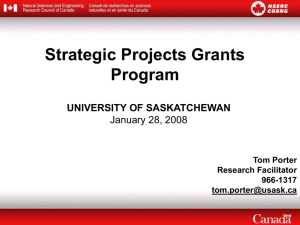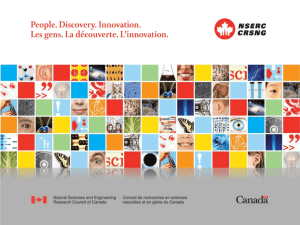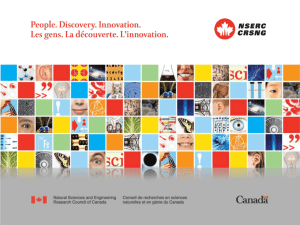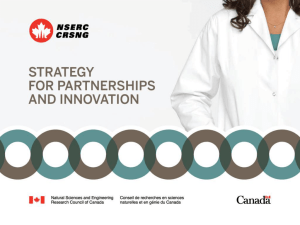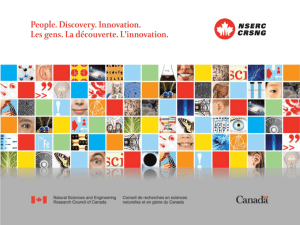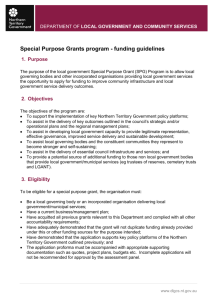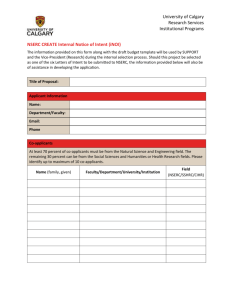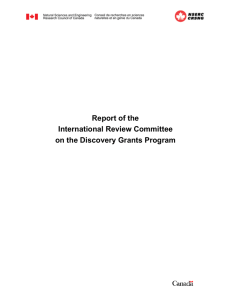Strategic Project Grants 2015 Competition SFU - January 2015
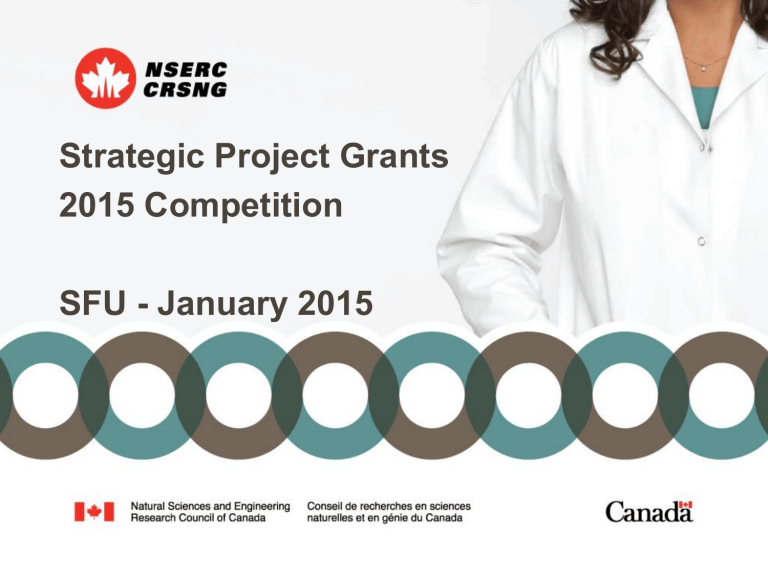
Strategic Project Grants
2015 Competition
SFU - January 2015
NSERC at a Glance
Total Budget 2014-15
$1.1 billion
Priorities
People
Attract and retain the best students and researchers in Canada by supporting more than 30,000 students and postdoctoral fellows.
Discovery
Enable Canadian scientists and engineers to become global leaders in their fields by funding more than 11,000 professors for their research programs.
Innovation
Increase Canada’s prosperity by building connections and supporting the application of research by funding research projects with over 2,600
Canadian companies.
2
RPP Programs
Strategic Partnerships
• Strategic Project Grants
• Strategic Network Grants
• Collaborative Health Research
Projects
• Automotive Partnership Canada
Training in Industry
• Industrial Postgraduate Scholarships
• Industrial Undergraduate Student-
Research Awards
Industry-Driven Collaborative R&D
• Collaborative R&D Grants
• Industrial Research Chairs
• Chairs in Design Engineering
• Interaction Grants
• Engage Grants
• Partnership Workshops Grants
College and Community Innovation
• Applied R&D Grants
• Applied Research Tools & Instrument
Grants
• College-University Idea to Innovation
Grants
• Industrial Research Chairs for Colleges
• Innovation Enhancement Grants
• Technology Access Centres Grants
Commercialization
• Idea to Innovation Grants
Strategic Partnerships
Program (30%)
2014-2015 RPP Budget
($299.1M)*
Industry-Driven Collaborative R&D
Program (48%)
College and Community
Innovation Program (16%)
*Does not include Networks of Centres of Excellence
Commercialization
Program (2%)
Training in Industry
Program (4%)
Why Strategic Project Grants?
• Focus on specific areas
• Opportunity to take research beyond the university
• NSERC will fund direct costs of a 3-year project including students, post-docs, consumables and equipment (major equipment items or systems are limited to a maximum of
$150,000).
• There must be significant involvement from the partner BUT a cash contribution is not required
Competition Statistics
Competition Year # of Applications # of Awards Success Rate
2014
2013
2012
2011*
2010
2009
2008
298
314
2007
*First competition with new target areas
309
314
425
547
465
352
78
75
81
70
122
122
129
149
26.2%
23.5%
25.8%
16.5%
22%
26%
37%
48%
Eligibility of Applicants
Applicant and Co-applicants
• Must hold, or have a firm offer of, an academic appointment at an eligible Canadian university, for:
− A tenured, tenure-track or life-time professor emeritus position; or
− A term position of no less than three years
• College Faculty can be co-applicants (see NSERC Website for list of eligible colleges)
• Co-applicants outside NSE must meet NSERC eligibility requirements
Co-Applicant vs. Collaborator
Eligible to hold NSERC funds and is an essential member of the team.
Not eligible to hold NSERC funds and should be contributing to intellectual direction of the project.
Must be qualified to undertake research independently but bring their own funds to the project.
Can be members of the research team
(i.e. government scientists, company staff members, research scientists from other countries).
Strategic Project Grants (SPG)
Objective
To increase research and training in targeted areas that could strongly influence Canada’s economy, society and/or environment within the next 10 years.
Expected Results
• New knowledge/technology with strong potential to strengthen
Canada’s industrial base, generate wealth, create employment and/or Canadian public policy
• Highly qualified personnel given an enhanced experience and trained in the target areas
• Increased participation of companies and/or government organizations in academic research
• Transfer of knowledge/technology to Canadian-based organizations that are well positioned to apply the results for economic gain or to government organizations to strengthen public policy
Requirements
The project must:
• Fall within one or more of the target areas
• Have well-defined objectives, scope and duration
(1-3 years)
• Have one or more eligible supporting organizations, actively involved in all stages of the project and that can apply the results
− In-kind contributions are required, but cash is optional
Four Target Areas
Priority research topics within:
• Information and Communications Technologies
• Environmental Science and Technologies
• Manufacturing
• Natural Resources and Energy
Please note: Health and related life sciences and technologies are covered under the Collaborative Health Research Projects (CHRP) Program
1. Information and Communications
Technologies
• ICT Devices and Systems
• Next-Generation Computing Platforms
• Advanced Communication Networks
• Application/Software Engineering
• From Data to Knowledge to Action
• Human Interaction with Digital Information
2. Environmental Science and Technologies
• Enhancing Aquatic Ecosystem Services
• Optimizing Water use in Industry
• Ensuring Secure Community Water Systems
3. Manufacturing
• Material Systems
• Automation, Process Improvement and
Inspection/Measurement
• Process and Product Modeling
• Sustainable Manufacturing
• Additive Manufacturing
4. Natural Resources and Energy
Natural Resources:
• Understanding Sources of Supply and Exploration for New
Resources
• Optimizing Resource Extraction, Harvesting and Renewal
• Enhancing Resource Conversion and Processing
• Improving Environmental Performance
Energy:
• Cleaner Fossil Fuels
• Renewable Energy
• Energy Use
• Energy Systems
Focused Research
• There are priority research topics identified within each target area
− At least 80% of budget is used to fund projects in these research topics
• Projects that fall outside of the research topics but fit the context of the target area are termed “Exceptional
Opportunities outside the research topics”
− up to 20% of budget can be used to fund these projects
• Research outside the 4 priority target areas will not be considered for funding and are not accepted fro evaluation
Non-Academic Supporting Organizations
Private sector
• Canadian-based companies or multi-nationals with
Canadian operations (R&D or manufacturing) that can apply the research results for economic gain
Public sector
• Canadian government organizations that can apply the research results to strengthen policies (the proposal must clearly show how the project relates to their public policy responsibilities)
Non-Academic Supporting Organizations
Do not qualify as the only supporting organization:
• NGOs
• Venture capitalists
• Government research labs
• Foreign research institutions
• Potential customers
• Hospitals and clinics
Supporting Organizations (continued)
A supporting organization must also:
• Have a demonstrated interest in the project (letters of support, in-kind contributions)
• Be involved in all stages of the research (help to develop the proposal, interact with researchers and students, provide input to the project)
• Validate the results of the research
• Provide guidance concerning exploitation of results
Supporting Organizations (continued)
• Refer to Guidelines for Organizations Participating in
Research Partnerships Programs
• Note: NSERC funds cannot flow to a supporting organization in any way e.g
. cannot use SPG funds to purchase equipment or supplies from the supporting organization(s)
Top Ten Tips
1.
Start early! Take full advantage of the Research Office and
NSERC staff. Their advice is invaluable.
2.
Make the application comprehensible to people outside your field and position your project within the current literature/state of the art - Literature review should not be Task 1 of project!
3.
Pay full attention to all aspects of the application, not just the research proposal (i.e. budget justification, in-kind contributions, relationship to other support).
4.
Make sure the partner is going to benefit actively from the research, integrated from the start and not just be an end user.
5.
Explain the fit to the target area clearly.
Top Ten Tips (continued)
6.
Ensure that all partners and co-applicants are fully involved.
7.
Understand how your proposal will be evaluated (all criteria are equally weighted!).
8.
Tailor your Form 100 to the Program you are applying to.
9.
Explain both the applied and basic aspects of the project.
10. Have another faculty member review your draft proposal against the evaluation criteria.
Reminders
• Strategic grants fund projects, not programs of research
• Provides opportunity for university researchers to carry out innovative science and engineering work with potential for commercialization or public policy impact
• Provides opportunity to introduce students to potential employers and for non-academic partners to access scientific expertise and specialized research equipment
Useful Links
• Use of grant funds: http://www.nserc-crsng.gc.ca/Professors-
Professeurs/FinancialAdminGuide-GuideAdminFinancier/FundsUse-
UtilisationSubventions_eng.asp
• Intellectual Property Policy: http://www.nserc-crsng.gc.ca/NSERC-
CRSNG/Policies-Politiques/ip-pi_eng.asp
The SPG Application
• Application for a Grant (Form 101) Parts I and II
• Personal Data Forms (Form 100) + CVs of collaborators (6 pages max)
• Form 183A (partner’s information and contributions)
• Letter of support (government organizations must have letters signed by the Director General or equivalent)
• Company Profile (discuss the nature of operations in Canada
(production, manufacturing, provision of services, or similar commercial activities)
The SPG Letter of Support
Letter of support must include
• the organization's support for and agreement with the proposal
• the reasons for being involved in the proposed collaboration;
• how the organization expects to integrate the results into its operations or to otherwise benefit from the anticipated outcomes;
• the further effort required to exploit the results in Canada;
• the potential for benefit to the Canadian economy and relevant time frame;
• the anticipated interaction of the organization's personnel with researchers from postsecondary institutions;
• the contribution to the direct costs of the research, in cash and in-kind
• if applicable, a description of the R&D programs with details of any public funding received that is directly related to the application
The SPG Application (continued)
Applicants must:
• Select a target area and research topic from the list provided
• Clearly explain in Proposal module (under ‘Introduction’):
1) why the proposed research is strategic; and
2) how it fits the target area and addresses the research topic selected
• Provide a compelling case for consideration if the research falls outside the research topics but within the target area listed
(“Exceptional Opportunity outside the Research Topics”)
Research Proposal- Format
• 11 pages total:
− Introduction (~1 page) – Clearly describe the fit to target area, research topic. Why is the research you propose strategic? Is the application a re-submission? How have concerns been addressed?
− Section 1 (~7 pages) – objectives, approach, workplan, roles of team members
− Section 2 (~1 page) – training plan
− Section 3 (~1 page) – interactions with supporting organizations, capacity of supporting organizations to exploit results, Intellectual
Property
− Section 4 (~1 page) – benefits to Canada
• Additional pages – references (2 pages max), relationship to other research, budget justification, details of in-kind contributions
International Collaborations
• Concurrent call for joint research projects
− Agence Nationale de la Recherche (France) National Science Council
(Taiwan) and Research Foundation for the State of São Paolo (Brazil)-
ALL TARGET AREAS
− Two separate but linked proposals: one submitted to each agency
− Canadian applications must meet all Strategic Project Grant requirements
− International agency will fund its scientists
− NSERC has not reserved funds for applications related to international concurrent calls
− Funding is on a competitive basis within regular SPG budget
− Up to 3 additional pages are allowed. See Detailed Instructions.
− There is no joint review
Additional Points to Consider
• Collaborations outside NSE: applicants are encouraged to collaborate with experts outside the natural sciences and engineering, where appropriate. Can represent up to 30% of the project costs and must be well integrated into the project.
• Overlap of funds: the onus is on the applicant to provide as much information as to how/why the project differs from those currently funded
(Relationship to Other Support).
• Provide as much detail as possible in your budget justification . Show all your calculations and how you arrived at totals presented. Reviewers do not enjoy spending hours recalculating how figures were obtained. Refer to Use of Grant Funds .
• Ensure that the hours you plan to work on the project are realistic.
• Funding decisions are announced in October. This should be considered in the activity schedule and workplan.
Evaluation Process- Timeline
• April 1Submission of Applications
• May/JunePre-Selection Process
− Preliminary review by target area selection committee members
− Proposals with significant weaknesses are removed
• July/AugustExternal referees
− Typically three per application
− Technical expertise to aid the panel’s decisions
− Appendix C: your suggestions
− Panel suggestions and NSERC database also used
• End AugustSelection Committee
− Proposals are assigned to three readers
− Discussion amongst the whole group
• OctoberResults announced
Pre-selection Process
• If the number of applications is very high, a pre-selection process will be applied.
• Proposals are evaluated by the Selection Panels using the seven evaluation criteria.
• Proposals with weaknesses will be removed from the competition and will not undergo external peer-review.
Evaluation Process
• Projects are evaluated against seven criteria
• Each criterion is graded from 1 (lowest score) to 4 (highest score). For details, see: http://www.nserc-crsng.gc.ca/OnlineServices-
ServicesEnLigne/instructions/101/e.asp?prog=spg
• Each criterion is of equal weight
• Only projects that are strong in all 7 criteria will succeed in obtaining funding
Selection Criteria
Originality of the research
Quality of the research
Project work plan
Quality of the applicants as researchers
Training potential
Interactions with the supporting organizations
Benefits to Canada and the supporting organizations
Selection Criteria
Originality of Research
The project must promise to generate new knowledge or to apply existing knowledge in an innovative manner.
• Novelty
• How the research relates to current state of knowledge
• Potential for developing new knowledge, products or processes
• Extent to which research will impact the field
• Potential for major scientific breakthrough
Selection Criteria (continued)
Quality of Research
The project must be scientifically sound and technically feasible.
It must fall within a specific target area.
• Focus and clarity of short- and long-term objectives
• Appropriate methodology
• Justification for approach based on existing knowledge
• Feasibility of research planned
• Does the research fit the Strategic Projects target areas?
Selection Criteria (continued)
Project Work Plan
The project must have a clear and coherent work plan that demonstrates a high probability of achieving the objectives in the proposed time frame.
• Clarity of project description
• Coherence of deliverables in work plan
• Probability of success within proposed time frame
• Availability of necessary equipment
• Roles and time commitment of research co-applicants (collaborative roles)
• Collaboration and communication plans
• Justification and need for funds
• Demonstrated management plan
Selection Criteria (continued)
Quality of the Applicants as Researchers
The research team must have all the expertise to address the defined objectives competently and to complete the project successfully.
• Does the team (including company researchers, if applicable) have all the required expertise?
• Form 100 very important
• Recognition of researchers’ achievements and contributions
• Appropriateness of skill sets of individual researchers in the proposed areas
• Roles and time commitment of research co-applicants (collaborative roles)
Selection Criteria (continued)
Training Potential
The project must provide opportunities to train students and other highly qualified personnel with skills relevant to the needs of Canadian organizations.
• Who will do the work? Graduate, undergraduate, and/or co-op students; technicians, post-docs and research associates? Is the type and number of HQP proposed appropriate for the project?
• Is the training relevant to the needs of Canadian organizations?
• Will the HQP have the opportunity to work in the non-academic partner’s facility?
• Workshops and training of industrial personnel at the applicant’s lab
• Track record of applicants in training HQP
• Suitability of the training environment
Selection Criteria (continued)
Interactions with Supporting Organizations
The supporting organizations must have the capacity to apply the results of the research and must be actively involved in all stages of the project.
• Is the supporting organization an appropriate partner?
• Do the project objectives fit with the priorities of the non-academic partner?
Remember that the partner organization will have to comment on the progress report midway through the project!
• How will the technology and knowledge be transferred?
• Is the non-academic partner able to assimilate new technology?
• What is the degree of involvement of the non-academic partner in developing the proposal and throughout the project?
• What kind of a track record do the applicants have in transferring knowledge and technologies?
Selection Criteria (continued)
Benefits to Canada and Supporting Organizations
The proposal must identify how the work will benefit the supporting organization and must demonstrate that exploitation of the research results will benefit Canada within a 10-year time frame.
• Delineate probable socio/economic/health/environmental benefits in a quantitative way…far more convincing! Where possible, describe the benefits in terms of an existing or future value chain.
• Is there a potential benefit in creating significant public policy as a result of the research?
• Is there potential to increase the numbers and/or quality of personnel working in an area of strategic importance?
Signs of a Good Proposal
• All sections are clear and well described:
− Clear summary, proposal easy to read
− Roles well defined (students, applicants …)
− Benefits to Canada clearly demonstrated
− Guidelines followed and requirements addressed
• Strong partner(s):
− Involvement from the start
− Clear expectations (including IP)
− Good communication
− On-going interaction
Reporting
Progress Report
- Halfway through the project, all grantees must submit a progress report and supporting organizations will be asked for their feedback.
- NSERC will pay the final instalment of the grant only if satisfactory progress and collaboration with the supporting organizations has been demonstrated.
Reporting
Final Report
- Three months after the project end date, all grantees must submit a final report on the project’s achievements with respect to its objectives.
- Each supporting organization in the project will be asked to evaluate the project.
Resources
For questions relating to fit to target area, eligibility of partners or applicants or requirements, please send your query to:
STRGR@nserc-crsng.gc.ca
For questions/support regarding the on-line application process, please contact:
Helpdesk: (613) 995-4273 webapp@nserc-crsng.gc.ca
